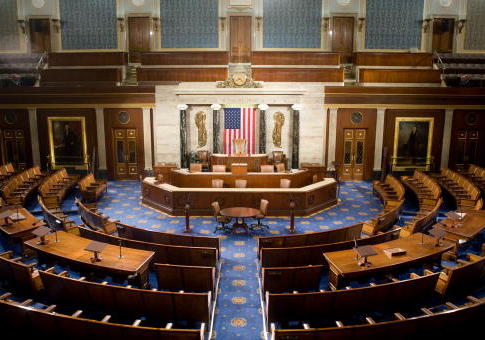The House of Representatives voted 237 to 189 to pass a ban on abortion after 20 weeks on Tuesday.
H.R. 36, officially the "Pain-Capable Unborn Child Protection Act," was reintroduced by Rep. Trent Franks (R., Ariz.) in January; House Majority Leader Kevin McCarthy (R., Calif.) announced last week that the bill would be brought to the floor.
The act would make it a crime to perform an abortion after 20 weeks of pregnancy. Violators would be subject to a fine, up to five years in prison, or both. It would make exceptions for the life of the mother, and for pregnancies that are the result of rape or incest. The act also specifically targets abortion providers; women who undergo an abortion after 20 weeks will not be prosecuted for violating the act’s terms.
Similar bills failed in 2013 and 2015, but this time the bill has support from the White House.
"The Administration strongly supports H.R. 36,... and applauds the House of Representatives for continuing its efforts to secure critical pro-life protections," a statement of administration policy reads. "The bill, if enacted into law, would help to facilitate the culture of life to which our Nation aspires. … If H.R. 36 were presented to the President in its current form, his advisors would recommend that he sign the bill into law."
A 20-week ban would bring the United States in line with the rest of the world. It is currently just one of six nations to permit elective late-term abortion without restriction—the other five are North Korea, China, Vietnam, Canada, and Singapore. The overwhelming majority of European countries ban abortion after the first trimester, just twelve weeks from conception.
The 20-week ban is also supported by the public: a poll in January, 2016 found that 80 percent support "some" restriction on abortions, with 60 percent specifically backing a 20-week ban.
The bill would impact a relatively small number of abortions. According to the Centers for Disease Control and Prevention (CDC), about 1.3 percent of abortions in 2013 were after 21 weeks; about 3.1 percent occurred after 18 weeks in the same year. A 2011/2012 study found that just 34 percent of abortion facilities offered abortions at 20 weeks, and 16 percent at 24 weeks.
The ban comes in the context of a decline in the number of abortions in America. Following its nationwide legalization in 1973, abortion rose, according to data aggregated by the Guttmacher Institute (Guttmacher was founded and is associated with abortion advocate Planned Parenthood; however, anti-abortion orgs including the National Right to Life Committee, consider their data more accurate than numbers collected by the CDC). The rate of abortions hit a peak in 1980/81—29.3 abortions per 1,000 women—and an absolute peak in 1990, when there were 1.6 million total abortions in the United States.
Since then, the rate of abortion has declined precipitously. As of 2016, it had fallen to just 14.6 abortions per 1,000 women, the lowest rate since Roe v. Wade legalized abortion nationwide.
Debate continues over what caused this decline. Some point to the increase in availability of reliable and cheap contraception. Others suggest that state-level laws imposing standards on abortion clinics and the procedure of abortion may have helped drive down the rate of abortion. One study pointed to Texas’s H.B. 2—which imposed hospital-like standards on abortion clinics before the Supreme Court struck it down in 2016—as being partially responsible for the 14 percent decline in abortions in Texas between 2013 and 2014.
As the House debated its 20-week ban, another forum met to discuss what work could be done to reduce abortions in America. Jeanne Mancini, president of the March for Life Education and Defense Fund, led a panel on "the current landscape for loving, life-affirming abortion alternatives that support women and families."
The centerpiece of the forum was the announcement of the March for Life’s 2018 theme: "love saves lives." The march, held every year since 1974, is, according to Mancini, "the largest annual human rights demonstration," with crowd sizes in the hundreds of thousands.
Mancini emphasized in her opening remarks that a culture of "love" was necessary for bringing abortion to an end. "I don’t know about you, but I think our culture needs love, real, sacrificial, heroic love, more than anything else right now," she said.
Alison Centofante, director of alliance relations at Alliance Defending Freedom, drew attention to the "thousands of pregnancy centers that are dedicated solely to helping women with unplanned pregnancy," such as the one run by co-panelist Susan Gallucci, executive director of the D.C.-based Northwest Center. Centofante also highlighted "federally qualified health centers," which offer whole-life medical services to women that abortion providers like Planned Parenthood do not.
"We also have federally qualified health centers, that we don’t talk enough about," Centofante said. "It’s 20 to 1 federally qualified health centers to Planned Parenthood centers. That’s a huge ratio. These federally qualified health centers are performing mammograms, things that Planned Parenthood can’t do. They’re looking for women’s health all the way through. That’s where our tax dollars should go, not towards abortion, not towards Planned Parenthood."
The 20-week ban now proceeds to the Senate, which blocked it in 2015. It is unclear how that body will vote this time around.
